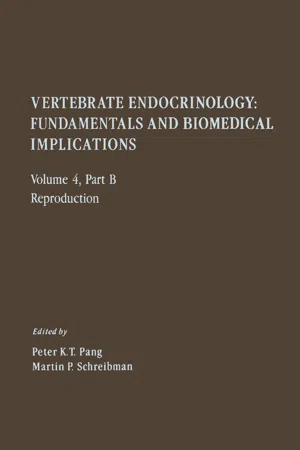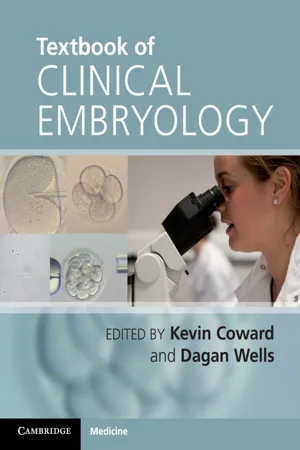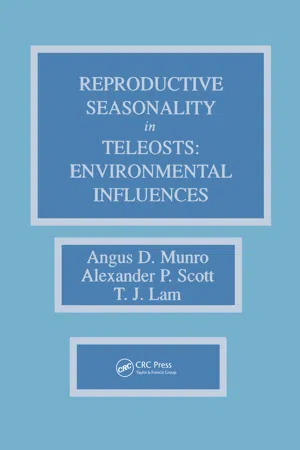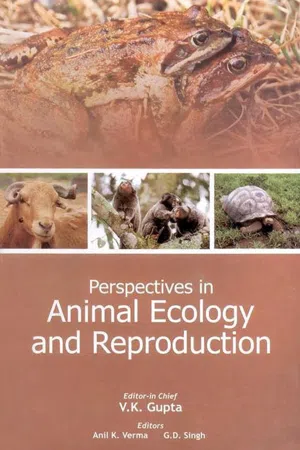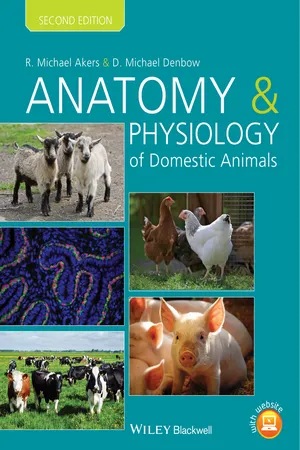Biological Sciences
Animal Reproductive Cycle
The animal reproductive cycle refers to the series of events and processes that occur in an animal's body to facilitate reproduction. This cycle typically involves the release of eggs or sperm, mating, fertilization, gestation, and birth. Hormonal changes play a crucial role in regulating the various stages of the reproductive cycle, ensuring the successful continuation of the species.
Written by Perlego with AI-assistance
Related key terms
1 of 5
7 Key excerpts on "Animal Reproductive Cycle"
- eBook - PDF
- Peter K.T. Pang(Author)
- 1991(Publication Date)
- Academic Press(Publisher)
13 Natural Regulation of Reproductive Cycles J. C. WINGFIELD AND G. J. KENAGY Departmntt of Zoology University of Washington Seattle, Washington I. INTRODUCTION Few, if any, animals inhabit constant environments; the world in which they live changes. For example, availability of food waxes and wanes with the seasons, in many cases with time of day, and water may only be accessible at certain times of the year. A 24-hr light-dark cycle pervades the environment, and temperature fluctuates on a daily basis as well as with the season. Thus, both general homeostasis and regulation of reproduction represent processes of adjustment to changing environmental conditions. For reproduction, the problem of timing is particularly critical. Breeding is seasonal, or at least periodic, in virtually all vertebrates. Indi-viduals undergo cycles of reproductive activity and inactivity. The gonads regress during the nonbreeding season (or period) and then develop (recru-desce) before the onset of the next period of breeding. In some cases the gonads may not regress once sexual maturity (puberty) has been attained but simply cease gamete production (i.e., spermatogenesis is suspended and ovulation does not occur). Some populations appear to breed continuously, although individuals of such populations show periods of breeding activity and inactivity that are asynchronous within the population. A very few species may indeed be continuous breeders (e.g., humans and some other large primates). Other species are flexible and temporally opportunistic, as are often found in unpredictable environments such as deserts where rainfall is irregular. These opportunists may retain functional, or nearly functional, gonads at all times so that reproduction can begin as soon as conditions become favorable. 181 VERTEBRATE ENDOCRINOLOGY: FUNDAMENTALS AND BIOMEDICAL IMPLICATIONS Volume 4, Part B Copyright © 1991 by Academic Press. Inc. All rights of reproduction in any form reserved. - eBook - PDF
- Kevin Coward, Dagan Wells(Authors)
- 2013(Publication Date)
- Cambridge University Press(Publisher)
Chapter 1 Sexual reproduction: an overview Suzannah A. Williams Introduction Reproduction is the production of offspring, propa- gating genes into the next generation, and exists in many forms within the animal kingdom. Each of these different strategies has advantages and disadvantages, but all strategies have evolved as the optimum for a particular species in a particular niche. Sexual repro- duction, as opposed to asexual reproduction, in the majority of cases involves the recombination of DNA to result in the generation of unique individuals. Of these individuals, some will be better adapted to exist in the surrounding environment than others, and these better suited individuals are most likely to be more successful. Therefore, this process of evolution not only results in the success of the fittest but also leads to intense competition for the best mate to pro- duce the ‘best’ next generation. For successful reproduction in mammals, i.e. the production of new viable offspring, there are many different stages that are essential not only in function but also timing. These stages include the production of functional gametes, appropriate behaviour to ensure the released gametes interact, a suitable environment for implantation and subsequent embryo develop- ment, birth to occur into a suitable environment and also for appropriate lactation to ensure the newborn is adequately provided for. Failure at any of these earlier stages can result in infertility ultimately failing to produce viable offspring, and in the worst case, threat- ens the life of the mother and of the fetus or newborn(s). Understanding how each of these events is regulated is critical for furthering our ability to influence these processes. This is critical not only to assist people who are unable to conceive naturally to have children, but also for other purposes such as to aid fertility in endan- gered species and to maximize reproduction for food production. - eBook - ePub
Reproductive Seasonality in Teleosts
Environmental Influences
- Angus D. Munro, Alexander P. Scott, T. J. Lam(Authors)
- 2019(Publication Date)
- CRC Press(Publisher)
II. Reproductive CyclesIn temperate and high latitudes, where most research is conducted, almost all animals and plants reproduce seasonally, and only a few species, many of which are domesticated or live in close association with man, breed throughout the year. In fact not only reproduction, but all other facets of life, including those linked to reproduction such as moulting, migration, food intake, growth, hibernation, and diapause, occur seasonally. The annual reproductive cycles of birds and mammals living in temperate and arctic climates are underpinned by pronounced changes in gonadotrophin secretion, leading to gonadal growth and greatly increased sex-steriod secretion. These changes can be very dramatic, especially in birds where, for example, the testes can increase in weight a hundredfold or more within a few weeks.1 By using appropriate experimental conditions, these cycles can be reproduced in the laboratory. Such studies have allowed researchers to unravel the physiological mechanisms underlying the cycles of certain species. These species, however, have been only those that are suitable for laboratory-based studies, and this has meant that only a few species have been intensively investigated, whereas nothing at all is known of the majority. Only about 20 species of birds, including sparrows, Japanese quail, starlings, and ducks and approximately the same number of species of mammals, including sheep, deer, mink, hamsters, and mice have been closely studied and even these to very different degrees. In both cases this represents less than 1% of the species within each class. Such a situation, which is even more extreme in the case of teleosts, which number over 20,000 species, means that it is difficult to make generalizations between species. Indeed, it can be difficult to generalize within a species. For example, northern populations of deer mice, Peromyscus maniculatus, have very discrete breeding seasons, whereas southern populations breed continuously2 (Figure 1 ). Not only is there considerable variation in the length of the breeding season in this species among populations living at different latitudes, but even at a single location there is also a great year-to-year variation in the length of the breeding season. The degree of variation both within and between locations is more pronounced in species of small animals than it is in larger ones, which is what is expected when energetics and life expectancies are considered.2 - Gupta, V K(Authors)
- 2021(Publication Date)
- Daya Publishing House(Publisher)
As a result, This ebook is exclusively for this university only. Cannot be resold/distributed. they differ greatly in the timing and sequences of life-cycle stages. Figure 24.1: Avian Life-History Stages (Nelson et al., 2001). The evolution of life history strategies in the organisms depends on their response to biotic and abiotic environment. Survival of any species in a non uniform fluctuating environment requires the development of mechanisms that permit an organism to adjust its important functions to changes of the environment. The most critical among these functions is the timing of reproduction, a scheme that causes reproductive activity to occur during the period which assures minimum stress on the adults and maximum probability for survival of young and parents. Reproduction is the part of life cycle with great environmental dependence (Immelmann, 1977). Since physiological preparations for reproduction begins long before the breeding season, the environmental factors selected by an organism for basic timing of its reproductive cycle, must have reliable predictive value, so that the physiological mechanisms controlling reproduction may be activated well in advance of the optimal environmental conditions, necessary for successful rearing of the young. Organisms having annually periodic reproductive season may use periodic changes in the environment as predictive information for the oncoming of favorable season for reproduction. The birds, like most other wild vertebrates, show a distinct temporal organization in their reproductive activity. Thus, for most bird species a precision in time of reproduction is of interesting occurrence (Farner, 1975). This ebook is exclusively for this university only. Cannot be resold/distributed. The time and duration of favorable season selected for reproduction differ among different climatic regions and different ecological groups of birds.- eBook - PDF
- Cecie Starr, Christine Evers, Lisa Starr, , Cecie Starr, Cecie Starr, Christine Evers, Lisa Starr(Authors)
- 2020(Publication Date)
- Cengage Learning EMEA(Publisher)
Animal Reproduction and Development 27.1 Assisted Reproductive Technology 567 27.2 Modes of Reproduction 568 27.3 Stages of Animal Development 569 27.4 The Human Reproductive System 571 27.5 Bringing Gametes Together 577 27.6 Human Development 579 27.7 Birth and Lactation 583 27.8 Fertility and Reproductive Health 584 27 Songbird nestlings are nourished by yolk as they develop inside an egg, then are fed by their parents after they hatch. CONCEPT CONNECTIONS The DNA in an animal’s chromosomes contains all the information necessary to build that animal (Chapter 8). During development, differences in gene expression give rise to different types of tissues and organs (Chapter 20). When an animal reproduces, mechanisms of cellular reproduction (Chapter 9) parcel the genetic information into new cells. In this chapter, you will learn how animals produce gametes by meiosis (Section 9.6), how hypothalamic and pituitary hormones (26.3) regulate production of sex hormones (26.8), and the role of sex hormones in reproduction. You will see how the three embryonic tissue layers (16.2) and the defining chordate features (16.6) form during development, and learn more about the function of the placenta, the defining feature of placental mammals (16.8). iStock.com/Kerrick Copyright 2021 Cengage Learning. All Rights Reserved. May not be copied, scanned, or duplicated, in whole or in part. Due to electronic rights, some third party content may be suppressed from the eBook and/or eChapter(s). Editorial review has deemed that any suppressed content does not materially affect the overall learning experience. Cengage Learning reserves the right to remove additional content at any time if subsequent rights restrictions require it. ANIMAL REPRODUCTION AND DEVELOPMENT CHAPTER 27 567 APPLICATION 27.1 Assisted Reproductive Technology Medical treatments that involve handling human eggs, sperm, and/or embryos are collectively referred to as assisted reproductive technologies. - No longer available |Learn more
- R. Michael Akers, D. Michael Denbow(Authors)
- 2013(Publication Date)
- Wiley-Blackwell(Publisher)
19 ReproductionContentsIntroduction Overview of the Female Reproductive TractPuberty in FemalesEstrous Cycles, Estrus, and OvulationEndocrinology of Female PubertyFertilization and PregnancyParturitionImplantation and PlacentationOverview of Male Reproductive TractSpermatogenesis Sperm Storage, Maturation, and DeliveryReproduction in BirdsAvian Female Reproductive System Avian Male Reproductive SystemReproductive TechnologiesChapter SummaryArtificial InseminationIn Vitro Fertilization (IVF)Embryo Transfer (ET) Sexed Semen Cloning Transgenic AnimalsIntroduction
What could be more fundamental to success of a species than reproduction? Understanding homeostasis and physiological controls are of limited use unless we can maintain our animals. Natural selection has produced an astounding variety of successful reproductive strategies. From an evolutionary viewpoint, the most favored pattern is one that results in the largest number of offspring reaching sexual maturity. Most population biologists have recognized two general patterns, namely, r-selection or K-selection. These terms were coined from logistic equations that were used to model growth of populations of animals in the wild.For r-selection animals, the investment in each individual is small both in a physical and energetic sense. Examples of this pattern of reproduction include fishes or amphibians that can produce extremely large numbers of eggs. The trade-off in producing so many small offspring is that there is little if any care of the offspring. They are produced and released into the environment to fend for themselves. It is estimated that only six out of a million mackerel fry survive to also reproduce. On the other hand, K-selection species produce fewer but larger offspring. Because these offspring are cared for—at least to some degree—during development, the chance that they will successfully reach reproductive age is far greater. Compared with the mackerel, individual K-selection animals may have a 50% chance of success. Clearly, for most agricultural operations the K-selection pattern predominates. - eBook - PDF
- William J. L. Felts, Richard J Harrison, William J. L. Felts, Richard J Harrison(Authors)
- 2013(Publication Date)
- Academic Press(Publisher)
Reproduction seems to be under the influence of an internal physiological rhythm and the external (physical and social) environment; the latter affects the animal via a chain of reactions: thermoreceptors, photoreceptors, sensory capacities-hypothalamus, CNS and cerebral cortex-endocrine glands-gonads. Future critical research using different species is suggested: (i) the relative importance of climatic and social factors; (ii) refractoriness of gonads under unfavorable environments; (iii) diurnal rhythms; and (iv) physioanatomical relationships between the hypothalamus and hypophysis ACKNOWLEDGMENT Thanks are due to Dr. Jean K. Lauber for reading the manuscript and making very helpful suggestions. References Ahmed, I. A., and Tantawy, A. O. (1959). Empire J. ExptL Agr. 27, 17. Alexander, G., and McCance, I. (1958). Australian J. Agr. Res. 9, 339. Alliston, G. W., and Ulberg, L. C. (1961). /. Animal Sci. 20, 608. 156 E. S. E. Hafez Arrington, L. G., Abplanalp, H., and Wilson, W. O. (1962). Brit. Poultry Sci. 3, 105. Aschoff, J. (1958). Tierpsychol 15, 1. Asdell, S. A. (1946). Patterns of Mammalian Reproduction. Cornell Univ. Press (Gomstock), Ithaca, New York. Asmundson, V. S., Lorenz, F. W., and Moses, B. D. (1946). Poultry Sci. 25, 346. Assenmacher, I. (1958). Arch. Anat. Microscop. Morphol. Exptl. 47, 447. Austin, C. R. (1956a). /. Exptl. Biol. 33, 348. Austin, C. R. (1956b). /. Exptl. Biol. 33, 338. Barnett, S. A., and Goleman, E. M. (1959). /. Endocrinol. 19, 232. Barnett, S. A., and Manly, B. M. (1959). Proc. Roy. Soc. B 151, 87. Barrick, E. R., Andrews, F. N., and Beeson, W. M. (1950). /. Animal Sci. 9, 387. Bastian, J. W., and Zarrow, M. X. (1955). Poultry Sci. 34, 776. Bauer, O. (1952). Arch. Gynäkol. 182, 359. Beach, F. A., and Jaynes, J. (1956a). /. Mammal 37, 177. Beach, F. A., and Jaynes, J. (1956b). Behaviour 10, 104. Benoit, J. (1950). Traite Zool. 15, 384. Benoit, J., and Assenmacher, I. (1953). Arch. Anat. Microscop. Morphol. Exptl. 42, 334.
Index pages curate the most relevant extracts from our library of academic textbooks. They’ve been created using an in-house natural language model (NLM), each adding context and meaning to key research topics.
